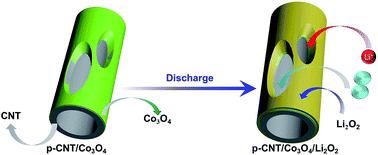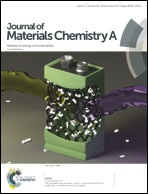Co3O4 functionalized porous carbon nanotube oxygen-cathodes to promote Li2O2 surface growth for improved cycling stability of Li–O2 batteries†
Abstract
Rechargeable non-aqueous Li–O2 batteries show great potential as an attractive energy storage system due to their ultrahigh theoretical energy density. However, their commercial application is restricted by the large charge overpotential originating from the low conductivity of the discharge product, which thereby results in poor cycle performance. Herein, we develop Co3O4 functionalized porous carbon nanotubes (p-CNT/Co3O4) as an efficient cathode catalyst for Li–O2 batteries. The abundant pore structures of p-CNT can facilitate efficient Li+ and O2 diffusion and provide more buffer interfaces to accommodate the discharge product Li2O2, leading to a high capacity. The functionalization of Co3O4 on the p-CNT surface can significantly enhance the O2 adsorption on the cathode surface and the formation of thin-film Li2O2 proceeds with the surface growth mode, thereby achieving a low charge overpotential. At a current density of 100 mA g−1, the p-CNT/Co3O4 shows an initial discharge capacity of 4331 mA h g−1 with a reduced overpotential of 0.95 V, and is able to work for 116 cycles at 200 mA g−1 with a fixed capacity of 500 mA h g−1.



 Please wait while we load your content...
Please wait while we load your content...